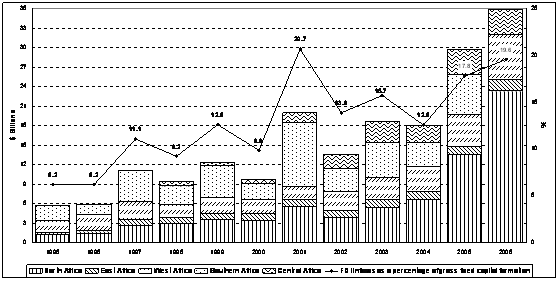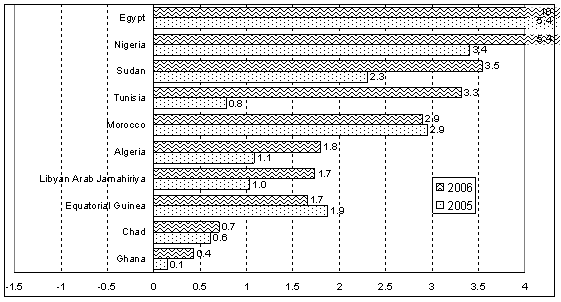| EMBARGO The contents of this press release and the related Report must not be quoted or summarized in the print, broadcast or electronic media before 16 October 2007, 17:00 GMT (1PM New York, 19:00 Geneva, 22:30 New Delhi, 02:00 17 October Tokyo) |
Foreign direct investment (FDI) into Africa doubled between 2004 and 2006 to a record US$36 billion (figure 1), spurred by the search for primary resources and increased profits and by a generally improved business climate, an UNCTAD survey of investment trends reports.
World Investment Report 2007: Transnational Corporations, Extractive Industries and Development(1), adds that the value of cross-border mergers and acquisitions (M&A) in Africa also reached a record level of $18 billion in 2006. About half of those M&As were accounted for by transnational corporations (TNCs) from developing Asia. Greenfield and expansion investments also grew significantly in Africa.
Despite these increases, the region´s share of the global FDI declined to 2.7% in 2006 from 3.1% in 2005. Africa´s portion of global FDI remains small when compared with figures for South, East and South-East Asia (15% of the world total) and Latin America and the Caribbean (6%).
African FDI outflows also reached a record level in 2006 of $8 billion, up from $2 billion in 2005, with South African firms being the main investors from the region (see UNCTAD/PRESS/PR/2007/037). FDI inflows exceeded $1 billion in eight African countries and rose in 33 countries in 2006. The top ten host African nations (figure 2) received about 90%, or $32 billion, of the continent´s inflows. North African countries hosted record incoming FDI, partly from Asian TNCs. All countries in this subregion except Morocco (where flows remained relatively large) received increased inflows in a variety of industries. In sub-Saharan Africa, FDI inflows climbed in all subregions except southern Africa because of large investments in oil and mining. Major investment declines, however, were recorded for Angola (-$1.1 billion) and South Africa (-$0.3 billion). These were due to sales of foreign equity shares to the Government in the former case and to local firms in the latter.
Both cross-border M&As and greenfield/expansion investments played an important role in the top host countries, particularly Egypt and Nigeria. In Egypt, the leading recipient in the region, inflows exceeded $10 billion, 80% of which were in non-oil activities. Nigeria was the main destination in West Africa, dominated by FDI in its oil industry, where investment came mostly from China.
There has been a surge of FDI flows to Africa in the primary sector, mainly oil, gas and mining, over the past few years. The services sector, particularly transport, storage and communications, also continued to attract FDI. Inflows into the manufacturing sector continued to grow in North African countries at a slow but stable rate, while in sub-Saharan Africa, no significant manufacturing FDI occurred.
The search for new resource reserves led to increased FDI inflows to African least developed countries (LDCs) to the tune of $8 billion, after a two-year decline. As a result, LDCs received 23% of FDI inflows to the region. The most significant increases among LDCs took place in Burundi, Djibouti, Guinea-Bissau, Somalia, Madagascar, Ethiopia, Cape Verde, Gambia and Sudan, where FDI inflows for new oil exploration and mining activities, as well as in the services sector, increased.
In terms of the investment climate for FDI flows to the region, in 2006 many African countries incorporated measures into their policy and regulatory frameworks to ensure steady inflows of FDI and to increase those flows which have the most positive impact on the development of their economies. Prospects for FDI into Africa continue to be positive because of high global commodity prices as TNCs, particularly from Asia, are taking advantage of good returns on investment. But some moderation is expected in 2007 due to a pause in large FDI inflows into the oil industries of some countries.
The World Investment Report and its database are available online at http://www.unctad.org/wir and http://www.unctad.org/fdistatistics |
ANNEX
Tables and figures
Figure 1: Africa: FDI inflows and theirs share in GFCF, 1995-2006
Source: UNCTAD, World Investment Report 2007
Figure 2. Africa: FDI inflows, top 10 economies, 2005-2006a(Billions of dollars)
Source: UNCTAD, World Investment Report 2007
Note: a Ranked on the basis of the magnitude of the 2006 FDI inflows.



